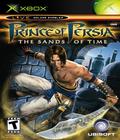Inspired, admired, and quite well-attired, the modern Prince of Persia represents a pinnacle of gaming heroes. To create a central character to whom players could immediately relate, who would provide the point of connection between gamer and game, the development team combined research, attention to detail, a massive amount of animations and cutting-edge physics. But they went even further - while the Prince possesses extraordinary abilities, he is human, and like any individual, he grows and evolves based on the experiences he encounters during the game.
Living the Adventure
In Prince of Persia: The Sands of Time, the Prince lives the adventure instead of living the game. A subtle difference, perhaps, but a crucial one: in addition to gaining access to more power and additional weapons as he progresses, the Prince also undergoes psychological changes as he advances on his quest to recapture the Sands of Time and restore peace to his land. To remain consistent with the overall level of quality in the game, the Prince reflects the story and content of the game - not just the aftermath of his actions. The team, inspired by Bruce Willis's transformation from Ordinary Joe to Fighting Machine in the first Die Hard, made sure that the main character is affected by the narrative arc of the story. Players can see these changes in a number of ways, including the Prince's wait animations. At the beginning, he's eager to fight, chomping at the bit and a bit nervous - later in the game, he becomes more focused, less eager, and more strategic.
More articles about Prince of Persia: The Sands of Time











 A rogue prince reluctantly joins forces with a mysterious princess and together, they race against dark forces to safeguard an ancient dagger capable of releasing the Sands of Time, which can reverse time and allow its possessor to rule the world.
A rogue prince reluctantly joins forces with a mysterious princess and together, they race against dark forces to safeguard an ancient dagger capable of releasing the Sands of Time, which can reverse time and allow its possessor to rule the world.











